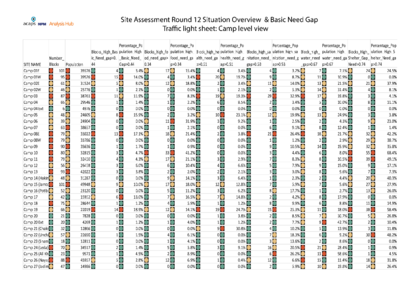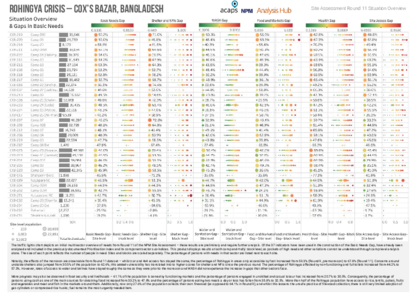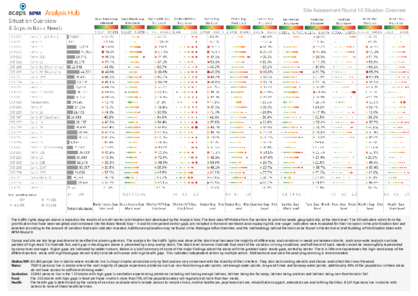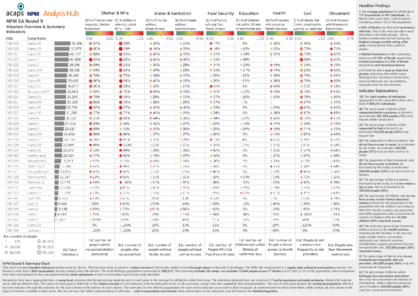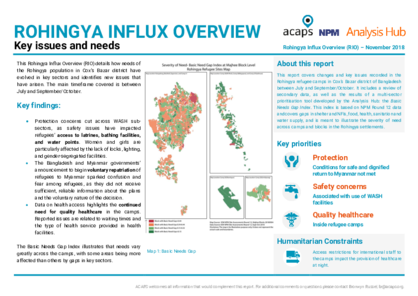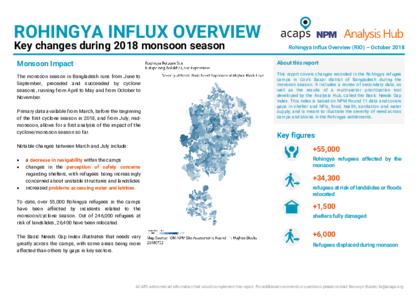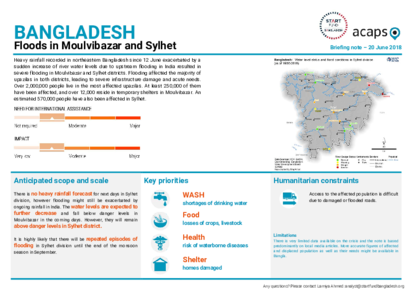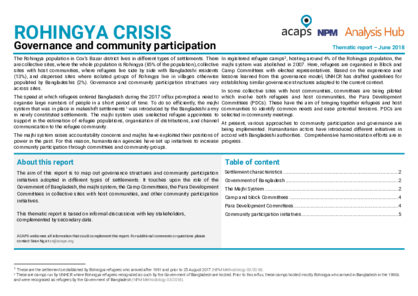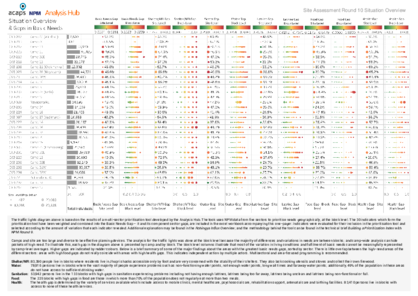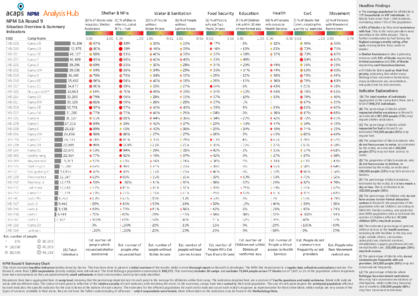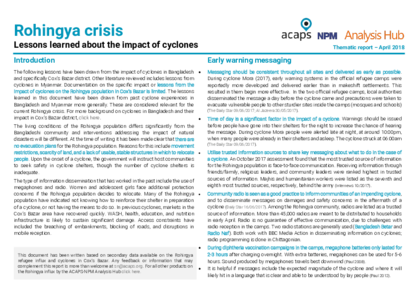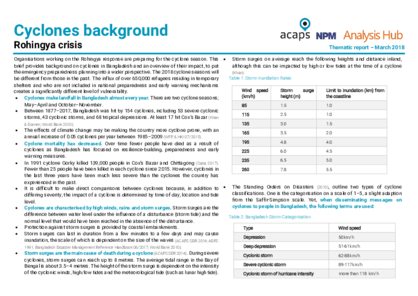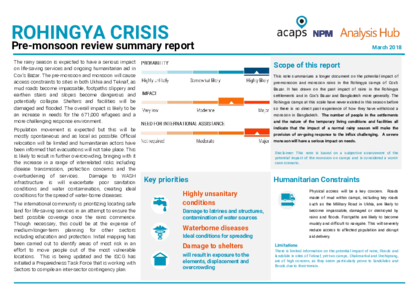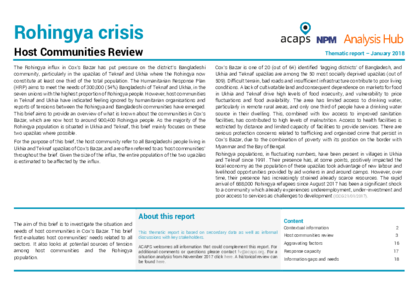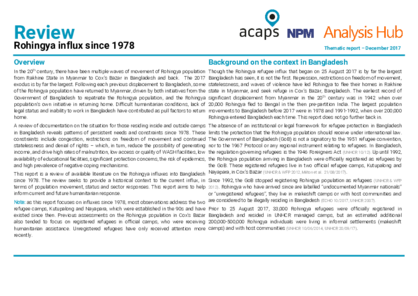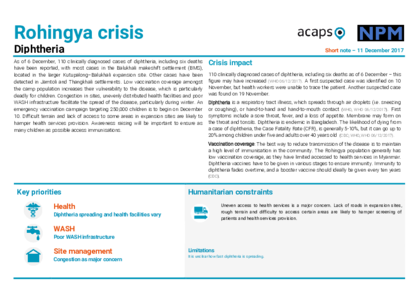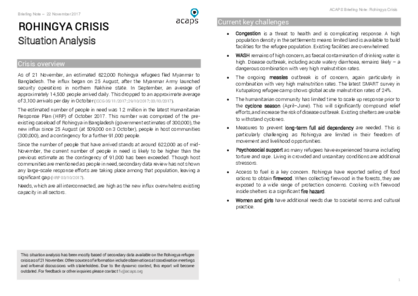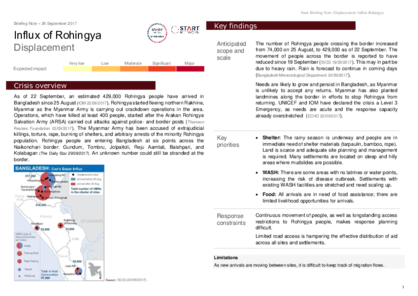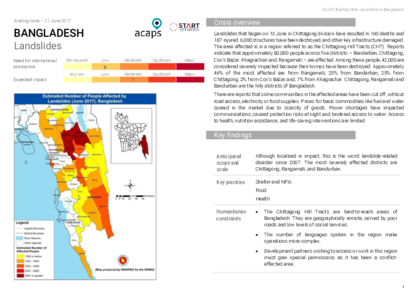Explore our
analysis products
archive
10 December 2018
Rohingya crisis: situation overview and gaps in basic needs
DOCUMENT / PDF / 4 MB
The traffic lights diagram above is based on the result of multisectoral priortrisation tool developed by Analysis Hub. The tool uses NPM site assessments Round 12 data from five sectors to priortise needs geographically, at majhee block level. The 32 indicators are selected from the sectors to build up composite index; combine to present basic need gap index at majhee block level.
10 December 2018
Rohingya crisis: situation overview and gaps in basic needs
DOCUMENT / PDF / 301 KB
The traffic lights chart depicts an initial multi-sector overview of needs from Round 11 of the NPM Site Assessment – these results are preliminary and require further analysis. Of the 37 indicators have been used in the construction of the Basic Needs Gap, have already been analysed and included in the previously-documented Prioritisation Index and its component sector sub-indices.
10 December 2018
Rohingya crisis: situation overview and gaps in basic needs
DOCUMENT / PDF / 718 KB
The traffic lights diagram above is based on the results of a multi-sector prioritisation tool developed by the Analysis Hub. The took uses NPM data from five sectors to prioritise needs geographically, at the block level. The 30 indicators which form the prioritisation tool have been weighted and combined into the Basic Needs Gap – it and its component sector gaps, are included in the excel workbook accompanying this one-pager.
10 December 2018
Rohingya crisis: situation overview and summary indicators
DOCUMENT / PDF / 678 KB
This chart contains headline indicators broken down by Sector. This has been done to present a initial overview of the results whilst a more thorough report on Round 9 is developed. The NPM Site Assessment is a regular data collection and analysis exercise.
16 November 2018
Rohingya Influx Overview (RIO): Key issues and needs
DOCUMENT / PDF / 2 MB
This report covers changes and key issues recorded in the Rohingya refugee camps in Cox’s Bazar district of Bangladesh between July and September/October. It includes a review of secondary data, as well as the results of a multi-sector prioritisation tool developed by the Analysis Hub: the Basic Needs Gap Index.
24 October 2018
Rohingya Influx Overview (RIO): 2018 Monsoon
DOCUMENT / PDF / 5 MB
This report covers changes recorded in the Rohingya refugee camps in Cox’s Bazar district of Bangladesh during the monsoon season. It includes a review of secondary data, as well as the results of a multi-sector prioritization tool developed by the ACAPS Analysis Hub, called the Basic Needs Gap Index.
21 June 2018
Bangladesh: Floods in Moulvibazar and Sylhet
DOCUMENT / PDF / 526 KB
Heavy rainfall recorded in northeastern Bangladesh since 12 June exacerbated by a sudden increase of river water levels due to upstream flooding in India resulted in severe flooding in Moulvibazar and Sylhet districts. Flooding affected the majority of upazilas in both districts, leading to severe infrastructure damage and acute needs.
06 June 2018
Rohingya crisis: Governance and community participation
DOCUMENT / PDF / 218 KB
The aim of this report is to map out governance structures and community participation initiatives adopted in different types of settlements. It touches upon the role of the Government of Bangladesh, the majhi system, the Camp Committees, the Para Development Committees in collective sites with host communities, and other community participation initiatives.
04 April 2018
Cyclones in Bangladesh: Lessons Learned
DOCUMENT / PDF / 237 KB
The following lessons have been drawn from the impact of cyclones in Bangladesh and specifically Cox’s Bazar district. Other literature reviewed includes lessons from cyclones in Myanmar. These are considered relevant for the current Rohingya crisis.
27 March 2018
Rohingya crisis: Cyclones background
DOCUMENT / PDF / 301 KB
Organisations working on the Rohingya response are preparing for the cyclone season. This brief provides background on cyclones in Bangladesh and an overview of their impact, to put the emergency preparedness planning into a wider perspective.
19 March 2018
Rohingya crisis: pre-monsoon review
DOCUMENT / PDF / 438 KB
This brief outlines the potential impact of rains, floods and landslides in the camps of Cox’s Bazar. To do so, it draws on past impact of rains in these camps, as well as in Cox’s Bazar and in Bangladesh more generally. It also draws on similar camp settings and natural disasters in other countries.
Attached resources
30 January 2018
Rohingya crisis: Host communities review
DOCUMENT / PDF / 2 MB
The aim of this brief is to investigate the situation and needs of host communities in Cox’s Bazar. This brief first evaluates host communities’ needs related to all sectors, and it also looks at potential sources of tension among host communities and the Rohingya population.
11 December 2017
Review: Rohingya influx since 1978
DOCUMENT / PDF / 774 KB
This report is a review of available literature on the Rohingya influxes into Bangladesh since 1978. The review seeks to provide a historical context to the current influx, in terms of population movement, status and sector responses. This report aims to help inform current and future humanitarian response.
11 December 2017
Rohingya crisis: Diphtheria
DOCUMENT / PDF / 294 KB
As of 6 December, 110 clinically diagnosed cases of diphtheria, including six deaths have been reported, with most cases in the Balukhali makeshift settlement, located in the larger Kutupalong–Balukhali expansion site. Other cases have been detected in Jamtoli and Thangkhali settlements. Low vaccination coverage amongst the camp population increases their vulnerability to the disease, which is particularly deadly for children.
22 November 2017
Rohingya Crisis: situation analysis
DOCUMENT / PDF / 1 MB
As of 21 November, an estimated 622,000 Rohingya refugees fled Myanmar to Bangladesh. The influx began on 25 August, after the Myanmar Army launched security operations in northern Rakhine state. In September, an average of approximately 14,500 people arrived daily. The estimated number of people in need was 1.2 million in the latest Humanitarian Response Plan of October 2017.
26 September 2017
Bangladesh: Displacement Influx of Rohingya
DOCUMENT / PDF / 354 KB
As of 22 September, an estimated 429,000 Rohingya people have arrived in Bangladesh since 25 August. Rohingya started fleeing northern Rakhine, Myanmar as the Myanmar Army is carrying out crackdown operations in the area. Operations, which have killed at least 400 people, started after the Arakan Rohingya Salvation Army carried out attacks against police- and border posts.
21 June 2017
Bangladesh: Landslides
DOCUMENT / PDF / 860 KB
Landslides that began on 13 June in Chittagong division have resulted in 160 deaths and 187 injured. 6,000 structures have been destroyed, and other key infrastructure damaged. The area affected is in a region referred to as the Chittagong Hill Tracts (CHT). Reports indicate that approximately 80,000 people across five districts – Bandarban, Chittagong, Cox’s Bazar, Khagrachari and, Rangamati – are affected.


